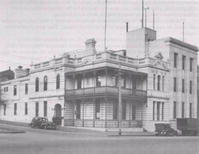


War History of the Australian Meteorological Service
Foreword
Preface
Introduction
Chapter 1: D.Met.S.—Australia's Wartime Weather Service
Establishment of D.Met.S. War Communication System
New Stations and Services
Censorship and Codes
RAAF Appointments
Organisational Conferences
Pacific Island Weather Stations
Services to the War Room
The Allied Air Meteorological Service
Training of US Personnel
Perth-Colombo Air-route
Wide Pacific Expansion
Closing Years of the War
Chapter 2: The Weather Factor in Warfare
Chapter 3: Met in the Retreat
Chapter 4: Met in the Advance
Chapter 5: Meteorology in Aviation
Chapter 6: Central Forecasting Services
Chapter 7: Met With the Army
Chapter 8: Research and Personnel Training
Chapter 9: Instrumental Development and Maintenance
Chapter 10: Scientific Developments in the RAAF Meteorological Service
Chapter 11: Divisional Bureaux and Their Work
Appendix 1: List of Reports Provided by D.Met.S. for Advances Operational Planning and Other Purposes
Appendix 2: List of Service Personnel RAAF Meteorological Service
Appendix 3: List of Civilian Personnel Who Worked Together with Service Personnel of the RAAF Meteorological Service
Appendix 4: List of Locations at which RAAF Meteorological Service Personnel Served
Index
Search
Help
Contact us

RAAF Appointments
In April 1941 personnel of the meteorological organisation who had volunteered for service with the RAAF, and who were medically fit, were enlisted for service in the new organisation. Mr H. N. Warren who, since May 1940 had been discharging the duties of Director of the civil organisation, was appointed as a Director of RAAF Headquarters Staff with the rank of group captain in charge of the RAAF Meteorological Service. Other officers were accorded ranks in accordance with establishment tables which had been drawn up by the Director and Air Members for Personnel and approved by the Air Board and Minister for Air.Organisational Conferences
At this time, there were differences of language, of codes and of coding methods in the meteorological services of the countries of the South-West Pacific and South-East Asia regions. The needs of possible war in the Pacific made it essential that uniformity be secured between probable allies.D.Met.S., after investigation, reported the problem to the then Chief of Air Staff (Sir Charles Barnett). Corrective action was promptly taken and, on 17 June 1941, Group Captain Warren represented Australia at a combined communications and meteorological conference at Batavia, NEI, attended also by service representatives of Great Britain, New Zealand, United States of America, Federated Malay States and NEI, to determine a uniform series of meteorological codes and ciphers for introduction by Allied services in the event of the Pacific becoming an active theatre of war. These codes and ciphers, which became known as the ANDUS system covered a triple purpose. They enabled uniform services for Allied Naval, Army and Air Forces by all meteorological services of the area without regard to nationality or language. Preparation for the system was delegated to the Australian meteorological service. Sqn Ldr (later Wing Commander) H. E. Camm, then officer in charge of the forecasting section at headquarters of the Directorate of Meteorological Services in Melbourne, was given the actual task of producing the cipher tables, which were given the short titles of ANDUSYN and ANDUSMET. Sqn Ldr Camm worked in association with the Australian Navy Office and the RAAF Director of Signals in their production. The ANDUS cipher systems were accepted by all Allied authorities in the region and went into operation throughout the region on 15 November 1941.

Design of a local COMETSYN code, an Australian internal weather ciphering medium, had meanwhile permitted resumption of the regional meteorological broadcasts.
Organisations in Australian Science at Work - Directorate of Meteorological Services (D.Met.S)
People in Bright Sparcs - Warren, Herbert Norman
 |
Bureau of Meteorology |  |
© Online Edition Australian Science and Technology Heritage Centre and Bureau of Meteorology 2001
Published by Australian Science and Technology Heritage Centre, using the Web Academic Resource Publisher
http://www.austehc.unimelb.edu.au/fam/0629.html